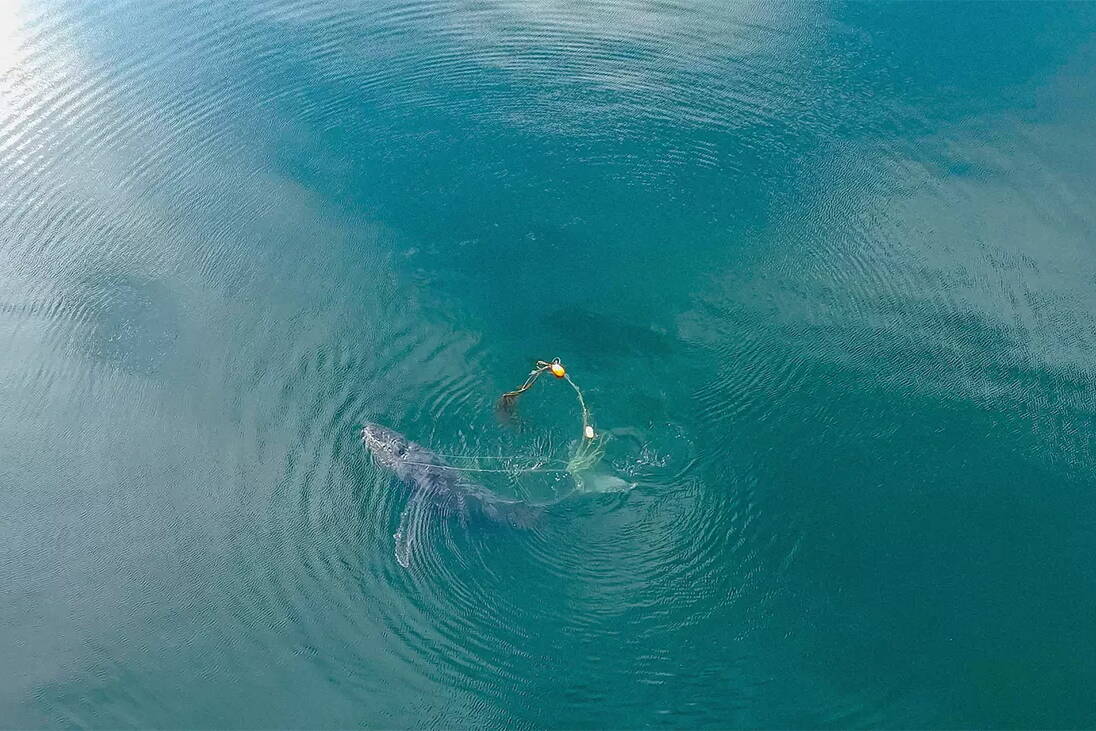It took a village to save a juvenile whale earlier this month, one that involved collaboration between people and agencies, and extended as far as a NOAA expert in Maui.
That’s the story of “SEAK-5490,” a juvenile humpback whale who was successfully freed from crab fishing lines near Gustavus earlier this month.
The effort included local residents who saw the humpback in distress and reported it, the owner of the fishing gear who provided information needed for the rescue, people on the Glacier Bay National Park entanglement response team, a volunteer photographer and FAA-licensed drone pilot, the NOAA Fisheries Alaska Regional Office, and their counterpart in Hawaii, and the Alaska Whale Foundation, according to a release sent out by the NOAA office.
The first step was assessing the whale’s condition, which they learned was dire. Janet Neilson and Chris Gabriele, of Glacier Bay National Park’s whale entanglement team, were able to determine the giant mammal was “semi-anchored in place” by two buoys attached to a 300-pound crab pot with heavy gauge line, according to the release.
That information was key for the response team, which came on the following day. Video and photographs taken by Sean Neilson, the drone pilot, showed a line was through the whale’s mouth and wrapped around its tail stock, the release said.
That information was used by Fred Sharpe of the Alaska Whale Foundation, a researcher and advanced large whale entanglement responder, and support teams from NOAA in Juneau and Hawaii to assist in the rescue. Ed Lyman at the Hawaiian Islands Humpback Whale National Marine Sanctuary in Maui provided his assessment via cell phone.
The team used specialized tools to remove the line and buoys, a series of cuts made “patiently and deliberately” to keep them at a safe distance. That included a knife at the end of a 25-foot carbon fiber pole. With each cut the whale became more mobile, until finally they were able to free the line that ran through its mouth and around its tail, according to the release.
Good weather aided the effort.
The following day Janet Neilson matched photos of the entangled whale’s fluke pattern that identified the humpback as SEAK-5490. The whale was first documented by the Alaska Whale Foundation in 2021 and seen two more times this year. That was facilitated by the Happywhale.com website, which matches humpback whale flukes to help track them.
It’s a happy outcome for a naturalist who was working on a whale boat that discovered the lifeless body of Tango, a whale calf who was later determined to have been killed by a vessel strike in August.
Tatyana Danahy-Moore, who goes by “Taz,” was working on a whale boat when the captain called her up to the wheelhouse. He wanted to confirm he was seeing a deceased whale before reporting it to NOAA.
“It was incredibly sad,” said Danahy-Moore. “You recognize them, get to know them.” She has worked on whale boats for several seasons and was also familiar with Sasha, Tango’s mother.
Danahy-Moore praised the team effort behind the rescue of SEAK-5490.
“It’s good to see that there are efforts that are still made, even after the peak of whale watching season,” she said. “It’s also amazing how our community comes together, along with NOAA, to work together to keep tabs on the whales and the wildlife so that if there is an entanglement, it’s very well documented.”
Glacier Bay National Park staff will document SEAK-5490’s conditions if they come across the whale in the coming weeks. They also remind people not to approach an entangled whale, and instead to contact experts.
• Contact Meredith Jordan at meredith.jordan@juneauempire.com or (907) 615-3190.

